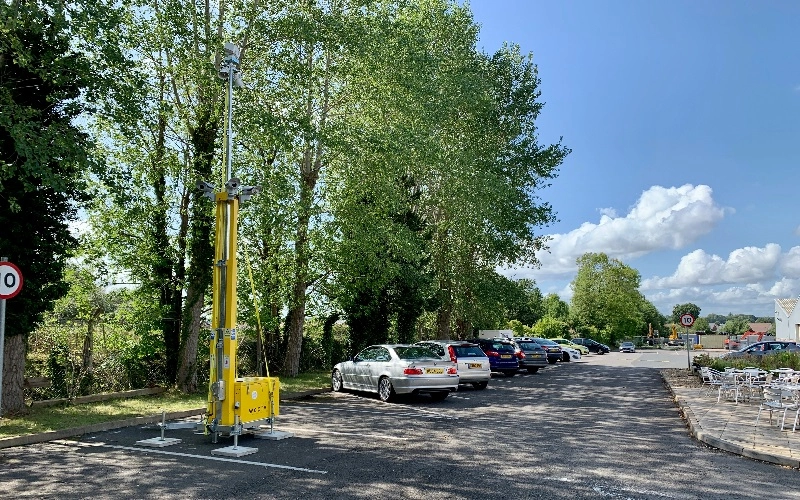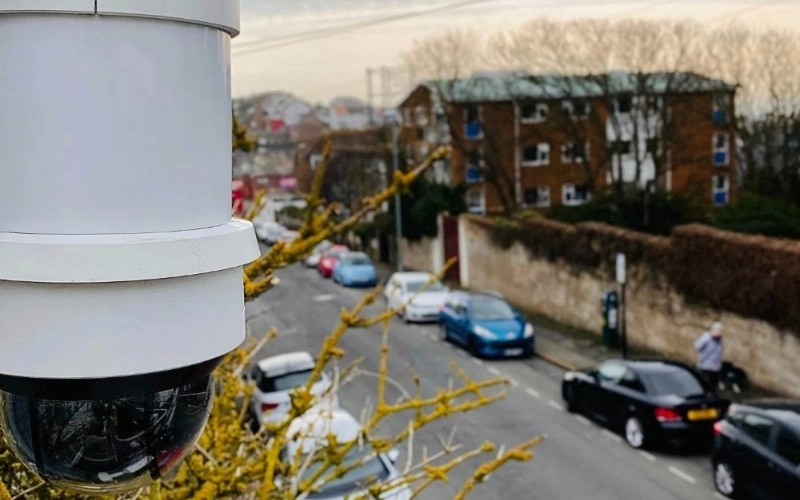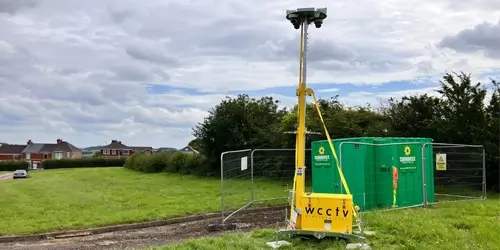Fly-tipping figures are at the highest they’ve ever been, leaving Local Authorities plagued with problems.
From high cleanup costs and disgruntled communities to public safety risks and environmental damage, the effects of fly-tipping extend much greater than the financials.
But, with budgets stretched and other responsibilities to manage, the demand for external support to reduce fly-tipping has grown dramatically.
Due to this, many Public Sector organisations are turning to mobile CCTV based on the cost-effective, flexible solution they offer in reducing fly-tipping.
Why are Local Authorities Turning to Mobile CCTV to Help Reduce Fly-Tipping?
Local Authorities are facing increased incidents of fly-tipping, especially with issues arising such as, bin strikes and tip closures placing increased pressures on the matter.
With the number of fly-tipping incidents rising every year, Local Authorities and Councils’ responsibilities are becoming greater, making the management of crime like fly-tipping extremely difficult.
Most areas and communities are now overwhelmed by fly-tipping and in order to both prevent and manage it effectively, Local Authorities are turning to mobile CCTV to provide them with those additional eyes in the sky.
The human eye only captures so much, and with a Government focus on reducing fly-tipping, there’s been a boost in funding opportunities which are allowing Local Authorities to enhance surveillance within their community.
Past funding has shown backing for mobile CCTV proposed by Local Authorities due to the numerous benefits provided in tackling fly-tipping, specifically their cost efficiencies.
How Mobile CCTV Helps Effectively Reduce Fly-Tipping
Most Public Sector organisations rely on funding to implement additional support on crime like fly-tipping, and this will often involve a tendering process to be completed as part of this.
You’ll need to be able to provide evidence within your tender in order to prove to those offering the funding that you require it and that the proposed solutions will benefit in reducing fly-tipping.
However, to do this, you need to be aware of how mobile CCTV can help effectively reduce fly-tipping, so that you can present this within a proposal, win bids and implement such measures.
Acts as a Visible Deterrent
Mobile CCTV units can be placed at fly-tipping hotspots, where their simple presence can visibly deter criminals from illegally dumping their waste.
Would-be criminals will view mobile CCTV cameras as an obstacle and fear the risk of being captured on video committing their crime. This alone is likely to be off-putting to them.
This visible deterrence can be enhanced through signage, indicating the presence of live CCTV and criminal liabilities for fly-tipping.
Also, certain mobile surveillance systems such as CCTV Towers are designed specifically to provide advanced visible deterrence, often standing tall and being bright in colour to help make their presence known further.

Collects Evidence for Prosecution
Fly-tipping often occurs under cover of darkness or in remote locations where there is an assumed lack of security and reduced risk of prosecution.
Mobile CCTV records events and gathers vital evidence to support in legal prosecution.
Advanced systems will be fitted with high-quality, IR PTZ (Pan, Tilt, Zoom) cameras that ensure crystal clear imagery, even in the dark, fog and mist.
This footage can be utilised by Police to identify any offenders and issue them with the appropriate response like, an FPN (fixed Penalty Notice).
Cost-Effective Solution Compared to Cleanup Fees
Recent Gov.uk data showed there were 1.15 million fly-tipping incidents between 2023/24, with 4% of those labelled as ‘tipper lorry load’ costing a total of £13.1 million in clearance fees across all Local Authorities in England alone.
And these costs only represent 4% of all fly-tipping incidents, there will also be costs related to the other 96% of incidents, making this figure much greater than can be imagined.
Whereas, with mobile CCTV solutions, you can save a significant amount on expenses by reducing the number of fly-tipping incidents and investing your budget or funding into effective preventative solutions that protect your community and avoid cleanup costs.
Easily Relocatable to New Hotspots
Like they say in their name, mobile CCTV are portable units that can be relocated from one fly-tipping hotspot to the next.
Fly-tipping is not a static crime, and in order to effectively reduce incident numbers, any additional support needs to be able to monitor various locations and cannot be permanently attached to one location.
Mobile CCTV tends to be easily relocatable, allowing you to stay on top of emerging threats and transition them to known hotspots to help minimise the subsequent consequences of such activity.
Provides Real-Time Monitoring
The advancements of real-time monitoring which mobile CCTV can offer, provides proactive, rapid incident response capabilities which can integrate into your existing security network.
These mobile units utilise wireless transmission that streams the live video feed to a monitoring centre who offer complete remote access, whether it be yours or a third-party supplier.
Following this, operators can monitor the specified fly-tipping hotspots, assess threats and respond in real-time, providing proactive preventative measures that go beyond supporting evidence gathering.
Early Threat Detection Through AI Video Analytics
The use of AI technology is becoming increasingly common within surveillance technology and bettering your response to fly-tipping.
Some manufacturers now include AI video analytics as part of their mobile CCTV solution. This additional feature allows for early threat detection, identifying suspicious behaviour as small as loitering.
This means that if your mobile CCTV unit identifies potential fly-tippers, the monitoring centre watching over this can deploy audio deterrence for prevention and call the Police to the scene.
AI video analytics ensure this action can be completed at the earliest possible stage, minimising the chance of fly-tipping happening in the first place.
Improves Community Confidence
Fly-tipping can create public safety risks, environmental hazards and visual damage, all of which cause issues within the community and health issues that Local Authorities and Councils are responsible for.
In order to protect your community, reduce fly-tipping and any health risks associated with this, mobile CCTV involves various features which can support all these areas effectively.
If your community is aware of the active prevention in place and the success in which it's having, you’ll boost their confidence and reduce the health risks related to fly-tipping.
Tracks Repeat Offenders
Mobile CCTV monitors and records events that can be analysed to establish any patterns, from repeat vehicles, offenders and popular times of day or night.
This helps refine your response to repeat offenders and track them precisely in future, but also in making data-led decisions that help disrupt any identified patterns.
Key Features to Look for in Mobile CCTV to Reduce Fly-Tipping
Generally, mobile CCTV is considered to provide various benefits that help to effectively reduce fly-tipping.
However, to maximise your protection against fly-tipping and ensure you include the correct mobile CCTV within your proposal, there are key features you should be looking for:
- Visual and Audio Deterrent Features - Including sirens, live audio challenge capabilities and bold design.
- Control Room Integration - Allows you to connect your existing security network to your mobile CCTV unit.
- Advanced Camera Technology - From infrared cameras to PTZ capabilities, consider your community needs and fly-tipping hotspots.
- Camera Add-ons - Mobile CCTV alone is beneficial, however, having the ability for ANPR (Automatic Number Plate Recognition) cameras, remote CCTV monitoring and AI video analytics to be added onto this refines your response and increases effectiveness.
- Relocatable Design - Fly-tipping hotspots will change and develop, so in order to effectively reduce this, you need your system to provide complete mobility and power autonomy.
- Multiple Powering Options - Some fly-tipping hotspots are in remote, rural locations where there is a lack of power or internet. You need to ensure your mobile CCTV has multiple powering options that can be tailored to your needs.

Why Choose WCCTV’s Mobile Security Solutions for Fly-Tipping Reduction
We have supported various Police, Local Authorities and Councils in reducing fly-tipping through Redeployable CCTV and Rapid Deployment CCTV Towers.
Our mobile CCTV solutions are backed by a best-in-class, fully-managed service that provides you with protection, as well as your community.
A small lapse in surveillance could create costly consequences, so we work innovatively to provide beyond the expected capabilities of mobile CCTV itself, from installing your system to providing ongoing customer care and technical support.
This helps to minimise downtime and help with fly-tipping reduction by combining our mobile security solutions with over 20-years of expertise.
And don’t just take our word for it, take the word of our clients.
Brighton & Hove City Council deployed our Redeployable CCTV Cameras to help reduce fly-tipping at key hotspots across the area.
Within the first 24 hours of installation, one single camera of ours caught six fly-tippers red-handed.
And after the first six months, this number had grown to 124, with fines totalling £50,000 issued - paying for the cameras multiple times over.
Looking for support with a future proposal? Speak with us about how our mobile CCTV solutions can support you.




